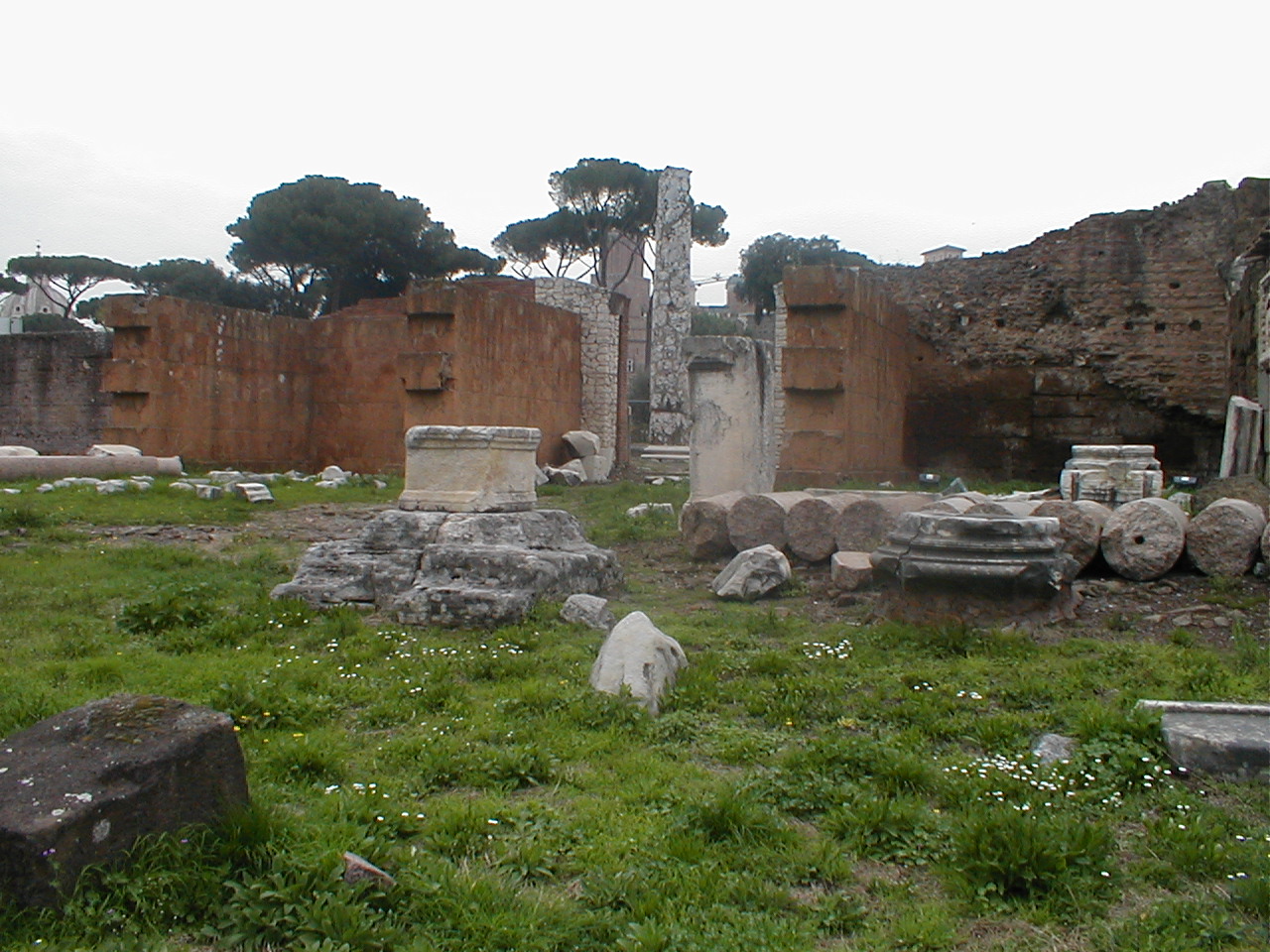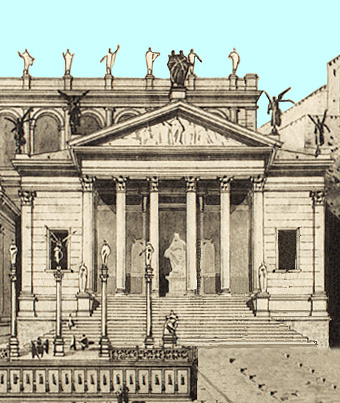|
Basilica Opimia
The Basilica Opimia was one of four Republican-era basilicas in the Roman Forum. The other two were the Basilica Aemilia, the Basilica Porcia, and the Basilica Sempronia. Of the three, only the Basilica Aemilia partially survives. It was built in 121 BC near the Temple of Concord and named after Lucius Opimius, who had financed its construction and that of the temple. When the Temple of Concord was enlarged under Tiberius the basilica had to be sacrificed and there is no record of its survival after that date. See also * List of monuments of the Roman Forum Bibliography *Filippo Coarelli Filippo Coarelli is an Italian archaeologist, Professor of Greek and Roman Antiquities at the University of Perugia. Born in Rome, Coarelli was a student of Ranuccio Bianchi Bandinelli. Coarelli is one of the foremost experts on Roman antiquiti ..., ''Guida archeologica di Roma'', Verona, Arnoldo Mondadori Editore, 1984. Opimia 120s BC establishments Roman Forum {{ancientRome-s ... [...More Info...] [...Related Items...] OR: [Wikipedia] [Google] [Baidu] |
Basilica
In Ancient Roman architecture, a basilica is a large public building with multiple functions, typically built alongside the town's forum. The basilica was in the Latin West equivalent to a stoa in the Greek East. The building gave its name to the architectural form of the basilica. Originally, a basilica was an ancient Roman public building, where courts were held, as well as serving other official and public functions. Basilicas are typically rectangular buildings with a central nave flanked by two or more longitudinal aisles, with the roof at two levels, being higher in the centre over the nave to admit a clerestory and lower over the side-aisles. An apse at one end, or less frequently at both ends or on the side, usually contained the raised tribunal occupied by the Roman magistrates. The basilica was centrally located in every Roman town, usually adjacent to the forum and often opposite a temple in imperial-era forums. Basilicas were also built in private residences an ... [...More Info...] [...Related Items...] OR: [Wikipedia] [Google] [Baidu] |
Basilica
In Ancient Roman architecture, a basilica is a large public building with multiple functions, typically built alongside the town's forum. The basilica was in the Latin West equivalent to a stoa in the Greek East. The building gave its name to the architectural form of the basilica. Originally, a basilica was an ancient Roman public building, where courts were held, as well as serving other official and public functions. Basilicas are typically rectangular buildings with a central nave flanked by two or more longitudinal aisles, with the roof at two levels, being higher in the centre over the nave to admit a clerestory and lower over the side-aisles. An apse at one end, or less frequently at both ends or on the side, usually contained the raised tribunal occupied by the Roman magistrates. The basilica was centrally located in every Roman town, usually adjacent to the forum and often opposite a temple in imperial-era forums. Basilicas were also built in private residences an ... [...More Info...] [...Related Items...] OR: [Wikipedia] [Google] [Baidu] |
Roman Forum
The Roman Forum, also known by its Latin name Forum Romanum ( it, Foro Romano), is a rectangular forum (plaza) surrounded by the ruins of several important ancient government buildings at the center of the city of Rome. Citizens of the ancient city referred to this space, originally a marketplace, as the ', or simply the '. For centuries the Forum was the center of day-to-day life in Rome: the site of triumphal processions and elections; the venue for public speeches, criminal trials, and gladiatorial matches; and the nucleus of commercial affairs. Here statues and monuments commemorated the city's great men. The teeming heart of ancient Rome, it has been called the most celebrated meeting place in the world, and in all history. Located in the small valley between the Palatine and Capitoline Hills, the Forum today is a sprawling ruin of architectural fragments and intermittent archaeological excavations attracting 4.5 million or more sightseers yearly. Many of the olde ... [...More Info...] [...Related Items...] OR: [Wikipedia] [Google] [Baidu] |
Basilica Aemilia
The Basilica Aemilia ( it, Basilica Emilia, links=no) was a civil basilica in the Roman Forum, in Rome, Italy. Today only the plan and some rebuilt elements can be seen. The Basilica was 100 meters (328 ft) long and about 30 meters (98 ft) wide. Along the sides were two orders of 16 arches, and it was accessed through one of three entrances. History Pre-existing building The new basilica was built on a site of the 5th-century BC ''tabernae lanienae'' ("butcher shops") and later (4th century BC) the ''tabernae argentariae''. The latter housed the city's bankers, and after a fire was renamed ''tabernae novae'' ("new shops"). The square had two facing rows of shops. A first basilica had been built behind the ''tabernae argentariae'' between 210 BC and 195-191 BC, the date in which it is mentioned by Plautus. Archaeological studies have shown that this building comprised three naves paved with tuff from Monteverde, the back façade having a portico which opened to the ''Fo ... [...More Info...] [...Related Items...] OR: [Wikipedia] [Google] [Baidu] |
Basilica Porcia
The Basilica Porcia was the first civil basilica built in ancient Rome. It was built by order of Marcus Porcius Cato in 184 BC as censor and is named after him. He built it as a space for administering laws and for merchants to meet, against some opposition. It stood to the west of the Curia, on land bought by Cato and previously occupied by shops and private houses. Many trials were held inside the basilica. It was destroyed by fire after the body of Publius Clodius Pulcher Publius Clodius Pulcher (93–52 BC) was a populist Roman politician and street agitator during the time of the First Triumvirate. One of the most colourful personalities of his era, Clodius was descended from the aristocratic Claudia gens, one ... was alit on a pyre in the adjoining senate house in 52 BC. The ruins were probably flattened later that year to build a new building on the site. Bibliography *Filippo Coarelli, ''Guida archeologica di Roma'', Verona, Arnoldo Mondadori Editore, 1984. Roma ... [...More Info...] [...Related Items...] OR: [Wikipedia] [Google] [Baidu] |
Basilica Sempronia
The Basilica Sempronia was a structure in the Roman Forum during the Republican period. It was one of four basilicas to make up the original Roman Forum alongside the Basilica Porcia, Basilica Aemilia, and Basilica Opimia, and was the third built. Although excavations have revealed remains of the basilica as well as the structures that originally stood in its place, none of them are visible from the Roman Forum. Construction Excavation of the basilica revealed that it was most likely constructed using tufa blocks, as was common in buildings of the time. Weak areas in the building may have been reinforced with travertine blocks, and the entire facade would most likely have been covered in stucco to hide the masonry as well as decorate it. The roof would have resembled those of temples and would have been made of wooden trusses and beams. The exterior of the roof would have been covered in tiles to protect the roof from the elements, and the interior would have been coffered to l ... [...More Info...] [...Related Items...] OR: [Wikipedia] [Google] [Baidu] |
Temple Of Concord
The Temple of Concord ( la, Aedes Concordiae) in the ancient city of Rome refers to a series of shrines or temples dedicated to the Roman goddess Concordia, and erected at the western end of the Roman Forum. The earliest temple is believed to have been vowed by Marcus Furius Camillus in 367 BC, but it may not have been built until 218 BC by L. Manlius. The temple was rebuilt in 121 BC, and again by the future emperor Tiberius between 7 BC and AD 10. History One tradition ascribes the first Temple of Concord to a vow made by Camillus in 367 BC, on the occasion of the ''Lex Licinia Sextia'', the law passed by the tribunes Gaius Licinius Stolo and Lucius Sextius Lateranus, opening the consulship to the plebeians. The two had prevented the election of any magistrates for a period of several years, as part of the conflict of the orders. Nominated dictator to face an invasion of the Gauls, Camillus, encouraged by his fellow patrician Marcus Fabius Ambustus, Stolo's father-i ... [...More Info...] [...Related Items...] OR: [Wikipedia] [Google] [Baidu] |






